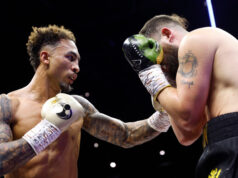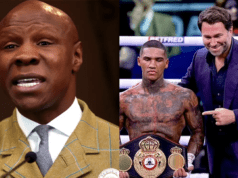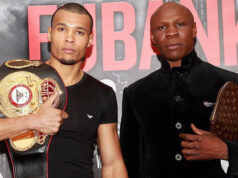Establishing the United States Boxing Commission
Professional boxing needs to address the issue of Performance Enhancing Drugs (PEDs) in the sport; the present anti-doping tests and procedures are inadequate and are in need of a major overhaul to protect the health and safety of fighters.
In every major boxing promotion thousands of dollars are paid for security at the event, but what about the security of fighters in the ring to ensure that they are fighting in a safe environment and on a level playing field? Who in the boxing industry is frightened to embrace a modern, effective, regulated and standardized drug testing code of practices & procedures to protect the health safety of all fighters and uphold the credibility, fairness, integrity and transparency of competition in the sport?
The answer should be nobody, so now is the time for action on this issue.
Senator John McCain made a strong statement to the floor of the U.S. Senate on June 18, 2012 indicating his intention to introduce the Professional Boxing Amendments Act of 2012; all who love boxing should support the Senator in his work to create a new federal United States Boxing Commission (USBC).
The first task of the new USBC should be to tackle the use of PEDs by some boxers in professional boxing and more importantly the lack of effective regulation and practices to detect boxers using banned drugs in the sport. The new Commission must have teeth if it is to be effective and make necessary change.
As many people close to professional boxing will testify, the boxing industry is a poorly regulated multi-million dollar business. The more un-regulated the business is, the greater the temptation is for some in the industry to act in an improper and unethical manner for their own selfish and strategic interests at the expense of others and the risk of destroying the reputation of the sport. Money and greed is the root of all evil and at times drags boxing into the gutter.
As former world champion Bernard Hopkins once said, “The business of boxing makes you want to take a shower every time you deal with it” and another former world champion William Gutherie once said “I love boxing, it’s the business of boxing turns my stomach.”
Senator John McCain’s Bill is designed to better protect professional boxing from the fraud, corruption, and ineffective regulation that has plagued boxing for too many years, and that has devastated physically and financially many professional boxers.
His statement reflects the views of so many, “the 19th century sportswriter Pierce Egan called boxing the ‘sweet science,’ while long-time boxing reporter Jimmy Cannon called it the ‘red light district of sports.’ In truth, it’s both. I have always believed that at its best, professional boxing is a riveting and honorable contest of courageous and highly-skilled athletes. Unfortunately, the last few decades of boxing history has – through countless examples of conflicts of interest, improper financial arrangements and inadequate or non-existent oversight – led most to believe that Cannon’s words best describe the state of boxing today.
“Ineffective oversight of professional boxing will continue to result in scandals, controversies, unethical practices, a lack trust in the integrity of judged outcomes and most tragic of all, unnecessary deaths in the sport. These problems have led many in professional boxing to conclude that the only solution is an effective and accountable federal boxing commission.” That is the establishment of the United States Boxing Commission (‘USBC’ or Commission)”
The media has recently reported cases of high profile fighters in the sport failing anti-doping tests. Many respected and investigative boxing writers at various times have highlighted the issue of PEDs in boxing on the internet, newspaper and magazines.
PEDs have been prevalent in the sport for a number of decades. It would be fair to comment that nobody knows the full extent of the use of PEDs due to the fact that present anti-doping testing practices to detect violations are inadequate and not all boxers are tested. Sophisticated users and those aiding and abetting them can avoid being caught and by doing so put their own health and the health of others in danger.
The reality is use of PEDs creates a dangerous imbalance in the ring, where one fighter is competing at a disadvantaged to the other. In this environment the health and safety of fighters is compromised and put at risk.
“The ring should be as fair and honorable as we can make it,” Dr. Edwin ‘Flip’ Homansky, Vice President of Voluntary Anti-Doping Association (VADA) once said. “No fighter should be allowed to gain an unfair advantage over his opponent. PEDs are an artificial aid and no different than tampering with a fighter’s gloves.”
The sweet science is a combat sport in which two fighters engage in a contest of endurance, power, strength and skill by throwing punches at an opponent with the goal of winning on points or by knockout.
When a fighter who has correctly trained and prepared for a fight and is naturally fatigued in the intensity of battle, but his opponent is not tiring and has plenty of gas in the tank due to taking PEDs, this is a scary and dangerous environment to be in and a fighter can be seriously injured or killed. It is not competition or an honorable contest when durability, endurance, performance and strength are enhanced by drugs by an opponent.
Weight categories in boxing are there for a reason; to create fairness and protect fighters in the ring, so that a physically big fighter with additional weight, height, reach and strength advantage is not unfairly competing with a physically small fighter. It used to be a fighter would compete at different weight classes over the lifetime of their boxing career, today with the use of banned drugs like Diuretics a fighter can be aided to weigh-in at one weight category and by the next day enter the ring weighing excessively heavier and a number of weight categories above the weight the fight was scheduled at. The USBC must examine and introduce rehydration weight limits to create a level playing field and protect fighters.
Boxing is only too familiar with the dangers of dehydration and re-hydration and fighters need to be protected from boiling down too much to a weight limit. This is where a good trainer and manager knows the limits and danger zone and ensures the health and safety of their fighter is paramount and comes first.
When PEDs are used in the sport like running, the volition of using illegal drugs can mean winning a race by seconds or yards, but in boxing the margin could be serious injury or life and death and that is the difference.
As former two times WBA heavyweight champion, John Ruiz aptly put it, “The only sport in which steroids can kill someone other than the person using them is boxing. You’re stronger when you use steroids. You’re quicker and faster. If a baseball player uses steroids, he hits more home runs. So what? I’m not saying that it’s right, but you’re not putting anyone else at risk. When a fighter is juiced, it’s dangerous. People go crazy about the effect that steroids have when a bat hits a ball. What about when a fist hits a head?”
The boxing industry has an integrity and creditability test to pass. Unfortunately the reality is the business is not capable of passing that test on its own and that is why a federal USBC is needed urgently to rescue professional boxing from its continual decline and slide. Testing and procedures are not generic and are different from one State to the next.
Then we have the ludicrous situation where high performance clean fighters are put under suspicion and their performances are unjustifiably questioned. This is another reason for reform in anti-doping tests and procedures, so that everything is transparent and all the ifs, buts and maybes are removed.
The industry needs to wake up and smell the coffee, clean fighters and boxing fans have had enough and they want the integrity of the sport restored and a zero tolerance adapted to drug use in boxing. Boxers that tested positive for drug use should be severely dealt with and banned from the sport.
The industry owes it to the majority of fighters who are clean to put measures in place to protect them from the cheats and rid the sport of the use of drugs. Fighters owe it to the next generation to be clean fighters, to act as role models to inspire young people by showing example and practicing the principles and values of true sportsmanship, fair play and respect for one’s opponent.
Negotiations for the biggest multimillion dollar super-fight of our times, Floyd Mayweather against Manny Pacquiao, at one time fell apart over the issue of drug testing. If the industry had in place an adequate and trusted regulated standard code of practice for drug testing perhaps the parties involved could have made the fight.
The first step on the road to recovery is for all in boxing to face up and admit there is a drug problem in the sport and that present testing practices are inept to properly detect and deter drug use.
Testosterone is the base all steroids are created or modeled on, enhancing strength, speed and recovery. It can be administered via gels, liquid and pellet injections, patches and creams.
Anabolic-androgenic steroids are the synthetic versions of testosterone. Human Growth Hormone (HGH) is an anti-catabolic hormone that stimulates cell reproduction, regeneration and growth. Erythropoietin (EPO) increases red blood cell production creating more oxygen in the blood to increase endurance.
Without an effective testing method for detection, the cheats will continue to use banned drugs and find ways to avoid being caught.
Any new USBC needs to consult with some of the experts in drug testing in sport the World Anti-Doping Agency, the Voluntary Anti-Doping Agency (VADA) and the United States Anti-Doping Agency (USADA). John Fahey, President of WADA, Dr Margaret Goodman, President of VADA and Travis Tygart CEO USADA and Dr. Richard W. Cohen, Chair of the USADA Board of Directors have diverse, experienced and talented individuals in this field.
One possible solution is that for all interim world and world title bouts and all major non-world title bouts that drug testing should be mandatory. The programme would have a combination of fixed dates and random dates for testing over an 8 week period before the date of the bout; tests would be both blood and urine. Testing would include the day of the fight before and after the bout.
The USBC would determine what tests that are used and when; the standard Testosterone/Epitestosterone ratio (T/E ratio) Test and Carbon Isotope Ratio (CIR Test) are used when testing urine samples.
The average male has a T/E ratio of 1:1, the WADA code allows for a 4:1 ratio, New York and Nevada allow a 6:1 ratio. An agreed ratio needs to be determined and this will be the standard for all Commissions in the USA.
Erythropoietin (EPO) is tested by doing blood tests.
All boxers granted licenses to fight in the USA regardless of their country of residence would be subject to mandatory random drug testing at any time of the year and not just in the 8 week period before the date of a bout. Those at the top end of the sport would be subject to more random drug testing – any time and any place.
Every Commission in every State in the USA would have the same Code of Practice, Regulation, Policy, Procedures and Rules for Anti-Doping Testing. A generic code of practice & regulations across the USA would also mean that all sanctioning bodies, promoters and fighters would have to abide by that code and regulations.
Sanctioning bodies, commissions, promoters and fighters would share the cost of Anti-Doping Testing in boxing. This is a multi-million dollar business, those that derive the most revenue and income will make the greatness contribution to pay for drug testing in the sport. Some of the cost can be factored into the adjustable gross revenue of promotions.
When fighters take 3 steps forward in the ring to put everything on the line everyone else takes 3 steps back to sit in the comfort and security of their seats, those taking their seats need to protect the health and wellbeing of all fighters and ensure the ring can be as safe an environment as possible.
Fighters and boxing fans hope the day when boxing can hold its head up as the noble art of self defence and fighters can compete on a level playing field in the absence of PEDs is not too far away. Boxers will enter the ring as equals touch gloves and the sentiment of all will be ‘may the best man or woman win.’
The United States has an opportunity to introduce anti-doping reform and provide an example to the rest of the world.










